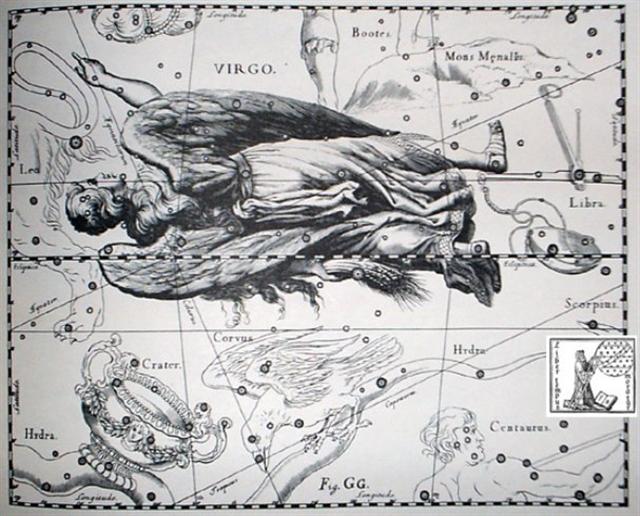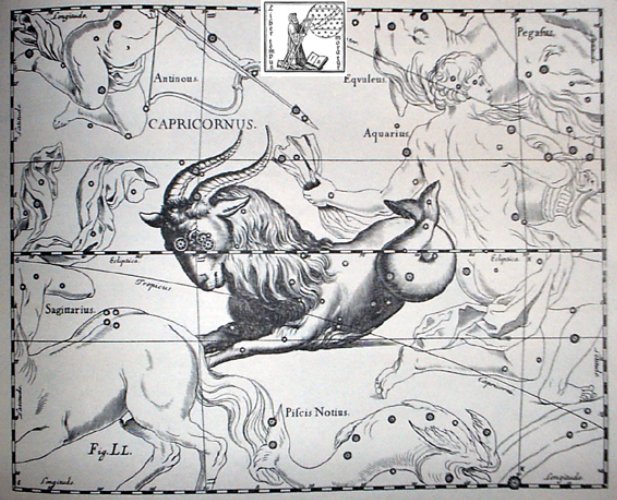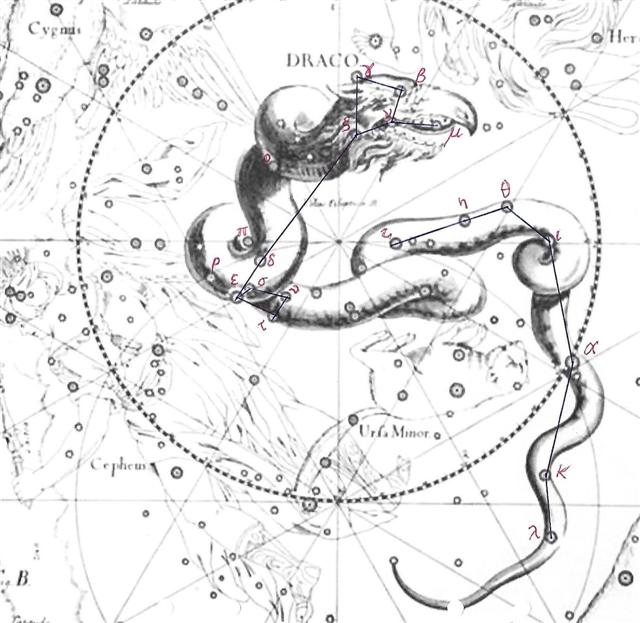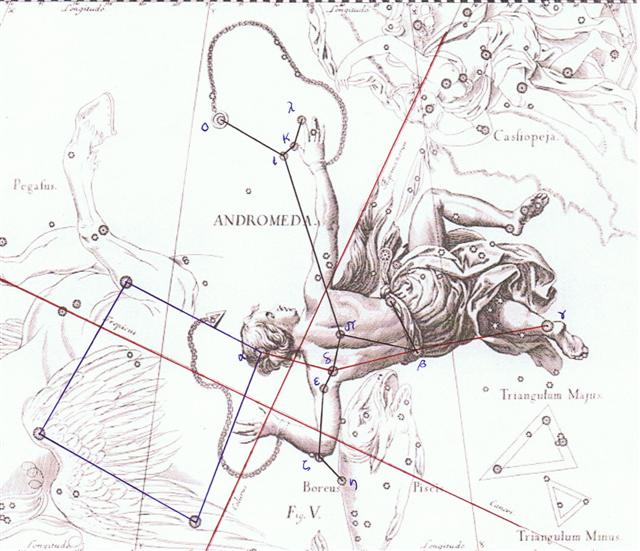There were 13 days from Spica to Arcturus and Spica was the star in the middle - both at the end of the Babylonian sequence and at the beginning of the Chinese sequence:
|
11 |
Mash-mashu-arkū |
Eastern
One of the Twins |
β
(Pollux)
Gemini |
116.2 |
July 15
(196) |
|
12 |
Arkū-sha-nangaru-sha-shūtu |
Southeast Star in the Crab |
δ
(Ascellus Australis)
Cancri |
131.4 |
July 30
(211) |
|
13 |
Rishu A. |
Head of
the Lion |
ε (Ras
Elaset Australis)
Leonis |
146.6 |
Aug 14
(226) |
|
14 |
Sharru |
King |
α
(Regulus)
Leonis
|
152.7 |
Aug 20
(232) |
|
15 |
Maru-sha-arkat-Sharru |
4th Son
behind the King |
ρ (Shir)
Leonis |
158.9 |
Aug 26
(238) |
|
16 |
Zibbat A. |
Tail of
the Lion |
β
(Denebola)
Leonis
|
178.3 |
Sept 15
(258) |
|
17 |
Shēpu-arkū sha-A |
Hind Leg
of the Lion |
β
(Alaraph)
Virginis
|
178.6 |
Sept 15
(258) |
|
18 |
Shur-mahrū-shirū |
Front or
West Shur (?) |
γ
(Porrima)
Virginis |
191.5 |
Sept 28
(271) |
| |
|
19 |
Sa-Sha-Shirū |
Virgin's
Girdle |
α
(Spica)
Virginis |
202.7 |
Oct 9
(282) |
 |
12 |
 |
|
Ga5-28
(138) |
Ga6-11 (151) |
|
SPICA |
ARCTURUS |
|
October
9 (282) |
October
22 (295) |
|
1 |
Horn |
α
Virginis (Spica) |
Crocodile |
(202.7) |
Oct
9 (282) |
282
= 265
+ 17 |
|
2 |
Neck |
κ
Virginis |
Dragon |
(214.8) |
Oct
21 (294) |
294
= 282
+ 12 |
|
3 |
Root |
α
Librae (Zuben Elgenubi) |
Badger |
(224.2) |
Oct
31 (304) |
304
= 295
+ 9 |
|
4 |
Room |
π
Scorpii (Vrischika) |
Hare |
(241.3) |
Nov
17 (321) |
321
= 304
+ 17 |
|
5 |
Heart |
σ
Scorpii |
Fox |
(247.0) |
Nov
23 (327) |
327
= 321
+ 6 |
|
6 |
Tail |
μ
Scorpii (Denebakrab) |
Tiger |
(254.7) |
Nov
30 (334) |
334
= 327
+ 9 |
|
7 |
Winnowing Basket |
γ
Sagittarii (Nash) |
Leopard |
(273.7) |
Dec
19 (353) |
353
= 334
+ 19 |
|
December solstice |
But we should review
the whole of the important line Ga5, from its beginning
(head) to its end (tail):
 |
 |
 |
 |
 |
|
Ga5-1 (111) |
Ga5-2 |
Ga5-3 |
Ga5-4 |
Ga5-5 |
|
JULY
10 |
11 |
12
(193) |
13 |
14 |
|
θ
Crateris (175.0), υ Leonis (175.2), ω Virginis
(175.3), ι Crateris (175.5) |
ο
Hydrae (176.1) |
ζ
Crateris, ξ Virginis (177.0), λ Muscae (177.1),
ν Virginis (177.2), μ Muscae (177.8) |
Al Sarfah-10 /
Uttara Phalguni-12 /
Zibbat A.-16 /
Shēpu-arkū
sha-A-17 |
Phekda, β Hydrae (179.3), η Crateris (179.9)
Deneb
Cygni |
|
93
LEONIS
(178.0),
DENEBOLA
(178.3),
ALARAPH
(178.6) |
|
September 12 |
13
(256) |
14
(*177) |
15 |
16 |
|
NAKSHATRA DATES: |
|
JANUARY 9 |
10 |
11 |
12 |
13
(378) |
|
λ Piscium (358.0),
MANUS CATENATA
(358.1), Alrai, θ Phoenicis (358.4), κ
Andromedae (358.7) |
ω Aquarii (359.2),
78 Pegasi (359.5) |
ψ Andromedae
(360.1), σ Phoenicis (360.4) |
γ¹ Oct. (361.4). φ
Pegasi (361.7) |
Dzaneb (362.4), γ²
Oct.(362.8) |
|
π |
March 15 |
16
(*360) |
17 |
18 (77) |
In the center of its first 5 glyphs is
the extraordinary Ga5-3, where the 'sky roof' of henua
is absent. This could be a sign to look at the nakshatra
(back) side instead of at the heliacal (front) side of the
structure. We will we then find Manus Catenata and the
π date (3-14) at Ga5-1.
March 16 at Ga5-3
was day 360 counted from March 21 in the previous year
and 360 - 183 = 177 = 6 * 29½. Which should have meant the Sun
in September 14 would have
moved halfway through his cycle of 12 synodic lunar
months. The basic measure of the G text was probably 16 * 29½ =
472 days and therefore there should have been 472 - 177
= 295 days beyond
JULY 12 (193), beginning at heliacal Denebola where
Virgo faced the Tail of Leo (Zibbat A.):

Counting 295 days
from the Tail of the Lion: March 16 (*360) + 295 = *655
= 365 + *290 (January 5):
 |
 |
 |
 |
 |
|
Ga4-23 |
Ga4-24 |
Ga4-25 (108) |
Ga4-26 |
Ga4-27 |
|
JULY 5 |
6 (*107) |
7 |
8 |
9 (190) |
|
φ Leonis (170.0), Alula (170.5), Labrum
(170.6) |
σ Leonis (171.1), λ Crateris (171.6), ι
Leonis, ε Crateris (171.9) |
γ
Crateris, π Centauri (172.0), κ Crateris
(172.5), τ Leonis (172.8)
GREDI |
ο¹ Centauri (173.8) |
GIAUZAR
(174.0), ξ Hydrae (174.3), ο² Centauri, λ
Centauri (174.8) |
|
September 7 |
8 |
9 |
10 |
11 (254) |
|
NAKSHATRA DATES: |
|
JANUARY 4 |
5 (*290) |
6 |
7 |
8 (373) |
|
ο Cephei
(353.3), Kerb (353.6) |
κ Piscium
(354.2), θ Piscium (354.4), υ Pegasi (354.9) |
ο Gruis,
Snowball Nebula
(355.0), τ Oct. (355.3) |
no star listed
(356) |
ι Phoenicis
(357.3), ι Piscium (357.4),
λ ANDROMEDAE
(357.9) |
|
March
9 |
10 |
11 |
12 |
13 (72) |


NGC 7662 Andromedae has been named the
Snowball Nebula. It was at the Full Moon when at the
heliacal side Gredi (α
Capricorni) culminated.
Giauzar was a name for
λ Draconis, the
last Greek lettered star in the Serpent's dwindling
tail, and λ was the star at the right forefinger of
Andromeda. Allen:
"Giansar and Giauzar are
variously derived: either from Al Jauzā',
the Twins, - a little star is in close proximity, - or
from Al Jauzah, the Central One, as it is nearly
midway between the Pointers and Polaris; or, and still
better, from the Persian Ghāuzar,
- Al Bīrūnī's Jauzahar
of Sāsānian origin, - the Poison Place, referring to the
notion that the nodes, or points where the moon crosses
the ecliptic, were poisonous because they 'happened to
be called the Head and Tail of the Dragon' ..."


|
Egyptian
menchet |
 |
Phoenician
lamedh |
 |
Greek
lambda |
Λ (λ) |
|
... Wikipedia has
no information regarding the origin of the
Phoenician lamedh, but the Egyptian
'cloth' hieroglyph (menchet) is - I
suggest - related to the 4 upside down sky
pillars. I.e. the basic element of the
'covering' hieroglyph could have indicated
darkness:
 |
I have derived my rongorongo dates from
the heliacal stars instead of from our own calendar
because since the time of Gregory XIII the precession
had moved the stars ahead in the year with 4 days -
pushing them out of their places in the
Gregorian calendar.
This means for instance that my date JANUARY 5 (64
days earlier than March 10) must be 4 days later than the corresponding date according to the Gregorian calendar (which had been frozen
in time since 1582 A.D.).
... In 1582 A.D. the stars must have
risen around 260 / 71 = ca 3.66 days earlier in the
year ... Recalibrating the stars from 1842 A.D. to
1582 A.D. means arranging them around 4 days earlier
in the calendar ...
 |
 |
 |
 |
 |
|
Ga4-23 |
Ga4-24 |
Ga4-25 (108) |
Ga4-26 |
Ga4-27 |
|
JULY 5 |
6 (*107) |
7 |
8 |
9 (190) |
|
JULY
1 |
2 |
3 |
4 (185) |
5 |
|
φ Leonis (170.0), Alula (170.5), Labrum
(170.6) |
σ Leonis (171.1), λ Crateris (171.6), ι
Leonis, ε Crateris (171.9) |
γ
Crateris, π Centauri (172.0), κ Crateris
(172.5), τ Leonis (172.8)
GREDI |
ο¹ Centauri (173.8) |
GIAUZAR
(174.0), ξ Hydrae (174.3), ο² Centauri, λ
Centauri (174.8) |
|
September 7 |
8 |
9 |
10 |
11 (254) |
|
ºSeptember 3 |
4 |
5 (*168) |
6 (249) |
7 |
|
NAKSHATRA DATES: |
|
JANUARY 4 |
5 (*290) |
6 |
7 |
8 (373) |
|
DECEMBER 31 |
JANUARY 1 (*286) |
2 |
3 (368) |
4 |
|
ο Cephei
(353.3), Kerb (353.6) |
κ Piscium
(354.2), θ Piscium (354.4), υ Pegasi (354.9) |
ο Gruis,
Snowball Nebula
(355.0), τ Oct. (355.3) |
no star listed
(356) |
ι Phoenicis
(357.3), ι Piscium (357.4),
λ ANDROMEDAE
(357.9) |
|
March
9 |
10 |
11 |
12 |
13 (72) |
|
ºMarch 5 |
6 (*350) |
7 |
8 |
9 (68) |
|










